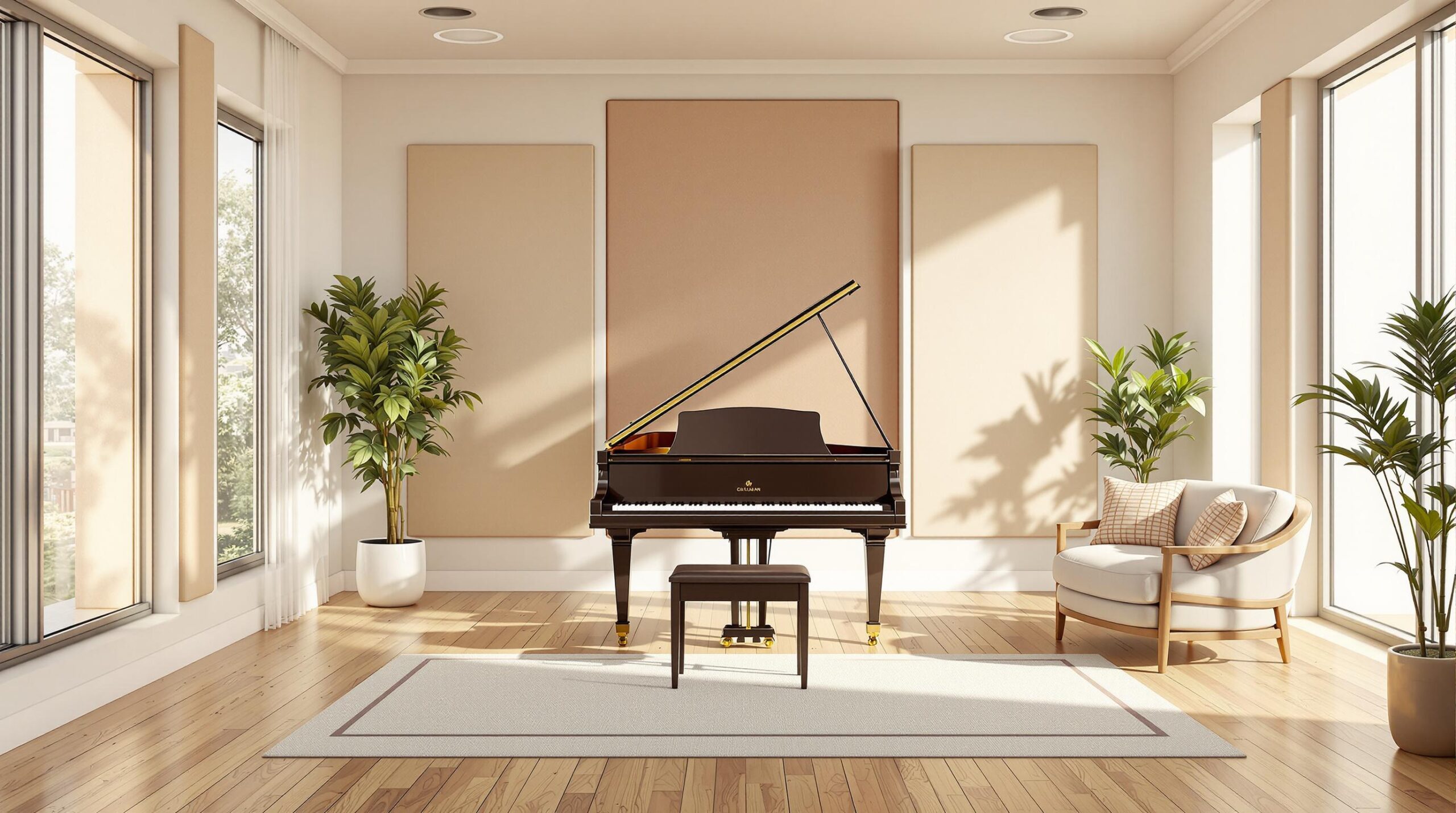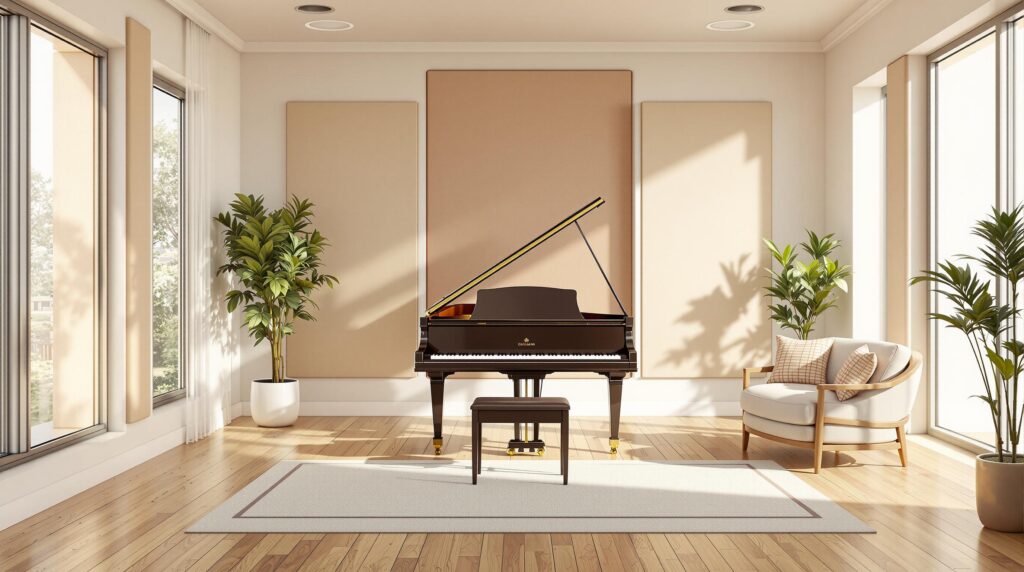
Want your piano to sound its best? Start by improving your room’s acoustics. Here’s how you can create a balanced, clear sound in just 5 steps:
- Assess Your Room: Test for echo, bass clarity, and sound reflections.
- Choose Materials: Use absorbers, diffusers, and bass traps to address issues.
- Place Treatments: Target walls, corners, and reflection points.
- Treat Ceiling & Floor: Add panels above the piano and rugs below it.
- Test & Adjust: Fine-tune placement and measure sound quality.
Before / After Acoustic Treatment-Residential Piano Music Room
Step 1: Check Your Room’s Current Sound Quality
Start by assessing your room’s acoustics to pinpoint areas that need improvement.
Room Size and Echo Time
Begin by measuring your room’s dimensions to understand its size and volume.
To check reverberation:
- Stand in the center of the room, clap your hands, and use your phone’s stopwatch to time how long the sound lingers.
- Ideally, the reverberation should feel balanced – clear without being overly sharp or too dull.
Identifying Sound Problems
Look for common acoustic issues by performing these simple tests:
- Flutter Echo: Stand near a wall and snap your fingers or make sharp sounds. Listen for repetitive echoes bouncing between parallel walls.
- Bass Clarity: Play low-octave tones or bass-heavy music to check how clear the low frequencies sound.
- Mid and High Frequencies: Walk around the room while playing scales or music with varying tones to assess the clarity of mids and highs.
- Corners and Low Notes: Play sustained bass notes in the room’s corners to see if low frequencies build up in those areas.
Write down your observations to help decide where to place acoustic treatments. If you’re unsure about your findings, consider consulting a professional for advice.
These tests will guide you in selecting and placing the right sound treatment materials in the next step.
Step 2: Pick the Best Sound Treatment Materials
Use the results from Step 1 to select materials that address your room’s specific acoustic challenges.
Types of Sound Treatment Tools
A combination of absorbers, diffusers, and bass traps can help tackle the issues identified in Step 1:
Acoustic Absorbers
- Acoustic panels made from high-density fiberglass or mineral wool (2–4 inches thick)
- Heavy sound-absorbing curtains for windows or large walls
- Fabric-wrapped panels with an NRC (Noise Reduction Coefficient) rating of at least 0.85
Sound Diffusers
- Wooden diffuser panels with well depths between 3–6 inches
- Curved or geometric surfaces to scatter sound effectively
- Polycylindrical diffusers for managing mid and high-frequency sound
Bass Traps
- Corner-mounted bass traps at least 4 inches thick
- Full-range absorbers to handle frequencies below 100 Hz
- Broadband bass traps for a more balanced low-end sound
Choose the right mix of these tools based on the specific problems identified in Step 1.
Material Quality Guide
When selecting materials, focus on the following factors:
Density and Thickness
- Absorbers: Minimum density of 6 lb/ft³
- Bass traps: At least 4 inches thick
- Diffusers: Depth of 3–6 inches for proper sound scattering
Material Construction
- Opt for Class A fire-rated, fire-resistant materials
- Ensure materials are moisture-resistant
- Use fabric coverings that are acoustically transparent
Coverage Recommendations
- Absorbers: Cover 15–25% of wall space
- Diffusers: Cover 10–15% of wall space
- Bass traps: Use 20% of the available corner space
Adjust the balance between absorption and diffusion based on the findings from Step 1 to create an acoustically effective environment.
sbb-itb-b8bc1ab
Step 3: Place Sound Treatments Correctly
Once you’ve chosen the materials, the next step is all about placing them in the right spots. Focus on the areas where sound reflects first to manage early reflections effectively.
First Sound Bounce Points
Here’s a simple way to pinpoint key spots for treatment using the mirror method:
- Have someone hold a mirror flat against the wall.
- Sit in your main listening position.
- Look for spots in the mirror where you can see your piano.
Install sound panels at these locations to cut down on reflections and improve the clarity of your piano’s tone.
Step 4: Treat Top and Bottom Surfaces
Once you’ve tackled wall reflections, it’s time to address sound bouncing off the ceiling and floor. These surfaces play a big role in shaping your piano’s acoustics and overall sound.
Managing Ceiling Reflections
Ceiling reflections can alter the way your piano sounds. Here’s how to handle them:
- Install cloud panels: Place these panels 12–18 inches below the ceiling directly above the piano. They help absorb and diffuse sound before it bounces back.
- Extend coverage: Make sure the panels stretch at least 4 feet beyond the piano’s footprint for better results.
- Use portable solutions if needed: If permanent panels aren’t an option, try portable acoustic clouds mounted with adjustable cables.
For sloped ceilings, align the panels parallel to the ceiling’s angle to ensure even sound absorption throughout the space.
Handling Floor Reflections
Floor treatment depends on the type of flooring you have:
-
Hard Floors (like hardwood, tile, or concrete):
- Place a high-quality area rug under and around the piano.
- Add a rug pad designed to dampen sound.
- Make sure the rug extends at least 3 feet beyond the piano’s footprint.
-
Carpeted Floors:
- For thin carpets, add a dense rug pad underneath for extra absorption.
- If the carpet is thick, it might already do the job, so focus on treating other surfaces in the room.
Pay special attention to the area between the piano and your main listening spot. This will help improve clarity and create a more balanced sound.
With the ceiling, floor, and walls addressed, you’re ready to move on to fine-tuning your setup in the next step.
Step 5: Test and Adjust Your Setup
After setting up your acoustic treatments, it’s time to tweak things to get the best sound quality.
Fine-tune Your Treatment Layout
Make small adjustments to your acoustic treatments based on how the room sounds. Pay attention to these areas:
- Panel positioning: Shift the acoustic panels slightly, especially around first reflection points. Small changes can help reduce unwanted reflections.
- Bass trap placement: Move bass traps in the corners or along walls to better manage low-frequency sounds.
- Diffuser orientation: Adjust the angle or position of your diffusers to create a more even sound distribution.
Tweak one element at a time and listen carefully to see how it affects the sound.
Measure Sound Quality
Evaluate the acoustics of your room with both your ears and measurement tools:
- Basic listening test: Play scales and chords across the piano’s range. Keep an ear out for:
- Notes that sound muddy or unclear
- Harsh or unpleasant resonances
- Uneven volume across the range
- Echoes or flutter echoes
- Professional evaluation: For a more precise analysis, consider hiring an expert. They can measure reverberation times, pinpoint problematic frequencies, and recommend specific adjustments to create a balanced sound environment.
Conclusion: Your Finished Piano Room
Key Takeaways
Improving your piano room’s acoustics can greatly enhance the sound of your instrument. Here’s a quick recap of the steps to achieve the best results:
- Room Assessment: Identify echoes and pinpoint problem areas.
- Material Selection: Use acoustic panels, bass traps, and diffusers.
- Strategic Placement: Position treatments at reflection points and in corners.
- Surface Treatment: Address sound reflections from ceilings and floors.
- Fine-tuning: Make adjustments based on listening tests and measurements.
Each of these steps works together to create a well-balanced acoustic environment, bringing out the best in your piano’s sound.
Cooper Piano Services
Take your piano setup to the next level with professional help. Cooper Piano offers services to complement your acoustic improvements:
- Tuning & Technical Support: Keep your piano in excellent condition with expert care.
- Professional Moving: Ensure precise placement for the best sound.
- Restoration: Improve your piano’s tone and overall quality.
- Consultation: Get advice on piano placement and maintenance.
With over 100 years of experience, Cooper Piano is dedicated to helping your piano and room acoustics work perfectly together.

